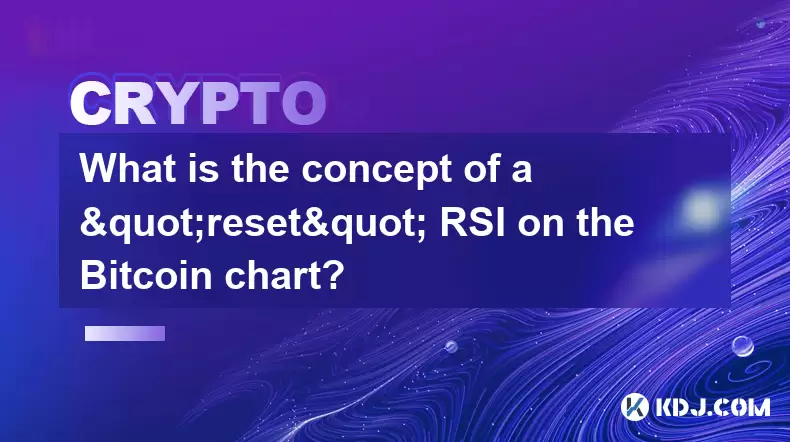-
 bitcoin
bitcoin $122090.672462 USD
1.59% -
 ethereum
ethereum $4493.758974 USD
0.56% -
 xrp
xrp $3.033145 USD
0.65% -
 tether
tether $1.000629 USD
0.00% -
 bnb
bnb $1169.854250 USD
7.07% -
 solana
solana $230.954786 USD
-0.19% -
 usd-coin
usd-coin $0.999785 USD
0.00% -
 dogecoin
dogecoin $0.256108 USD
-1.12% -
 tron
tron $0.342333 USD
-0.12% -
 cardano
cardano $0.859632 USD
-0.10% -
 hyperliquid
hyperliquid $48.932146 USD
-2.25% -
 chainlink
chainlink $22.345466 USD
-1.29% -
 ethena-usde
ethena-usde $1.000217 USD
-0.03% -
 avalanche
avalanche $31.203456 USD
1.93% -
 sui
sui $3.579145 USD
1.05%
What is the concept of a "reset" RSI on the Bitcoin chart?
Traders adjust Bitcoin's RSI thresholds during strong trends, treating higher levels like 80+ as overbought to better align with evolving market dynamics and avoid premature exits.
Jul 06, 2025 at 05:36 pm

Understanding the RSI Indicator in Cryptocurrency Trading
The Relative Strength Index (RSI) is a widely used technical analysis tool that measures the speed and change of price movements to evaluate overbought or oversold conditions. In the context of Bitcoin trading, the RSI typically oscillates between 0 and 100. A reading above 70 suggests overbought territory, potentially signaling a pullback, while a value below 30 indicates oversold conditions, possibly hinting at a rebound.
In the Bitcoin market, where volatility is high and sentiment can shift rapidly, traders rely on RSI to time entries and exits. However, due to the unique nature of cryptocurrency markets, standard RSI settings may not always provide reliable signals. This has led some traders to explore alternative interpretations, such as the concept of a 'reset' RSI.
What makes the RSI different for Bitcoin compared to traditional assets? The decentralized and highly speculative nature of Bitcoin means that trends can persist longer than expected, making standard RSI thresholds less effective without adjustments.
Defining the 'Reset' RSI Concept
A 'reset' RSI does not refer to a formalized indicator but rather to an interpretation method where traders reset or recalibrate their expectations of what constitutes overbought or oversold levels based on new market dynamics. In simpler terms, after a significant price movement, the baseline for evaluating RSI values may need to be adjusted.
For example, during strong bull runs, Bitcoin’s RSI may remain above 70 for extended periods without a meaningful correction. In such cases, traders might consider resetting the RSI reference point higher—say, treating 80 or even 85 as the new overbought threshold.
- Traders observe prolonged RSI readings beyond traditional levels
- Market psychology shifts, altering how RSI should be interpreted
- Adjustments are made dynamically instead of relying solely on fixed thresholds
How Does a Reset RSI Manifest on the Bitcoin Chart?
When examining a Bitcoin chart, a 'reset' RSI becomes evident when the price sustains momentum in one direction while the RSI remains outside typical overbought or oversold zones. For instance, during the 2020–2021 bull cycle, Bitcoin's RSI often hovered above 70 for weeks without triggering a reversal.
This phenomenon leads traders to question whether the asset has entered a new phase where conventional RSI rules no longer apply. In these situations, experienced traders may choose to reset their analytical framework by reevaluating historical RSI extremes specific to the current trend.
Why would someone reset their RSI interpretation mid-trend? Because failing to adapt could result in premature exits or missed opportunities during strong directional moves.
Identifying When to Consider a Reset
Recognizing when to consider an RSI reset requires careful observation of both price action and volume. Key signs include:
- Price continues to trend despite RSI being in extreme territory
- Volume supports the ongoing trend, reinforcing its legitimacy
- Historical patterns show similar behavior under comparable market conditions
Traders can use multiple time frame analysis to confirm if a reset is warranted. If the daily chart shows sustained momentum and the weekly RSI hasn't reached an absolute extreme, it might justify adjusting the interpretation range.
Can volume help validate a reset RSI scenario? Yes, rising volume during extended RSI extremes strengthens the case for a new normal in momentum-based trading.
Practical Application: Using Reset RSI in Bitcoin Trading
To practically apply the concept of a reset RSI in Bitcoin trading, traders must first establish a dynamic understanding of current market behavior. Here’s how to approach it step-by-step:
- Compare current RSI readings with recent historical data – Look at the past 6 months to identify new relative extremes.
- Overlay trendlines on the RSI itself – This helps visualize support/resistance within the indicator space.
- Observe divergence patterns – Even during strong trends, hidden divergences can signal potential exhaustion points.
- Combine with moving averages or volatility bands – Use tools like Bollinger Bands or Ichimoku Clouds to cross-verify signals.
By adopting this flexible approach, traders avoid rigid interpretations and stay aligned with evolving market conditions.
Is there a risk in ignoring traditional RSI levels entirely? Yes, especially during consolidation phases or sudden reversals triggered by macro events.
Frequently Asked Questions (FAQ)
Q: Can I automate the detection of a reset RSI condition using trading bots?A: While bots can track deviations from average RSI ranges, fully automating a reset RSI strategy requires custom scripting and adaptive logic that goes beyond basic algorithmic setups.
Q: Are there any indicators that work better than RSI during strong Bitcoin trends?A: Moving Average Convergence Divergence (MACD) and Volume Weighted Average Price (VWAP) tend to offer clearer signals during trending environments, especially when combined with RSI resets.
Q: How often should I reassess my RSI thresholds when trading Bitcoin?A: Reassess whenever there’s a notable shift in volatility, volume, or trend structure—typically every few weeks or after major price breakouts.
Q: Does the reset RSI concept apply to altcoins as well?A: Yes, many altcoins exhibit similar behavior during Bitcoin-led rallies, though they may experience sharper and more frequent corrections, requiring more frequent resets.
Disclaimer:info@kdj.com
The information provided is not trading advice. kdj.com does not assume any responsibility for any investments made based on the information provided in this article. Cryptocurrencies are highly volatile and it is highly recommended that you invest with caution after thorough research!
If you believe that the content used on this website infringes your copyright, please contact us immediately (info@kdj.com) and we will delete it promptly.
- BlockDAG, DOGE, HYPE Sponsorship: Crypto Trends Shaping 2025
- 2025-10-01 00:25:13
- Deutsche Börse and Circle: A StableCoin Adoption Powerhouse in Europe
- 2025-10-01 00:25:13
- BlockDAG's Presale Buzz: Is It the Crypto to Watch in October 2025?
- 2025-10-01 00:30:13
- Bitcoin, Crypto, and IQ: When Genius Meets Digital Gold?
- 2025-10-01 00:30:13
- Stablecoins, American Innovation, and Wallet Tokens: The Next Frontier
- 2025-10-01 00:35:12
- NBU, Coins, and Crypto in Ukraine: A New Yorker's Take
- 2025-10-01 00:45:14
Related knowledge

Why is Bitcoin considered a revolutionary technology?
Aug 12,2025 at 08:29pm
Decentralization and the Elimination of Central AuthoritiesThe core innovation behind Bitcoin lies in its decentralized architecture, which fundamenta...

Why is Bitcoin considered a revolutionary technology?
Aug 10,2025 at 07:42pm
Decentralized Architecture and Trustless TransactionsBitcoin is considered revolutionary because it introduced a decentralized architecture that opera...

What are the key features of Bitcoin?
Aug 10,2025 at 02:50am
Decentralization and Peer-to-Peer NetworkOne of the most defining characteristics of Bitcoin is its decentralized nature. Unlike traditional financial...

Can the Bitcoin protocol be changed?
Aug 07,2025 at 01:16pm
Understanding the Bitcoin ProtocolThe Bitcoin protocol is the foundational set of rules that govern how the Bitcoin network operates. It defines every...

Can the Bitcoin protocol be changed?
Aug 11,2025 at 01:01am
Understanding the Bitcoin Protocol StructureThe Bitcoin protocol is the foundational set of rules that govern how the Bitcoin network operates. These ...

What happens to Bitcoin transactions once they are confirmed?
Aug 09,2025 at 05:22am
Understanding Bitcoin Transaction ConfirmationWhen a Bitcoin transaction is initiated, it is broadcast to the network and placed in a pool of unconfir...

Why is Bitcoin considered a revolutionary technology?
Aug 12,2025 at 08:29pm
Decentralization and the Elimination of Central AuthoritiesThe core innovation behind Bitcoin lies in its decentralized architecture, which fundamenta...

Why is Bitcoin considered a revolutionary technology?
Aug 10,2025 at 07:42pm
Decentralized Architecture and Trustless TransactionsBitcoin is considered revolutionary because it introduced a decentralized architecture that opera...

What are the key features of Bitcoin?
Aug 10,2025 at 02:50am
Decentralization and Peer-to-Peer NetworkOne of the most defining characteristics of Bitcoin is its decentralized nature. Unlike traditional financial...

Can the Bitcoin protocol be changed?
Aug 07,2025 at 01:16pm
Understanding the Bitcoin ProtocolThe Bitcoin protocol is the foundational set of rules that govern how the Bitcoin network operates. It defines every...

Can the Bitcoin protocol be changed?
Aug 11,2025 at 01:01am
Understanding the Bitcoin Protocol StructureThe Bitcoin protocol is the foundational set of rules that govern how the Bitcoin network operates. These ...

What happens to Bitcoin transactions once they are confirmed?
Aug 09,2025 at 05:22am
Understanding Bitcoin Transaction ConfirmationWhen a Bitcoin transaction is initiated, it is broadcast to the network and placed in a pool of unconfir...
See all articles










































































